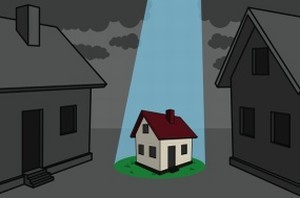News and Events
October 26, 2009

Downsizing: Today's Home Buyers Are Thinking Small
What does the new American home look like? The shift is obvious as soon as you step through the front door. The grand entryway — the two-story foyer with a sweeping, often multipronged staircase — is quickly giving way to a more modest entrance. Stairs are less about architectural flourish and more about getting upstairs (if you can imagine). That means they're either moving back up against the wall or turning into more-compact switchbacks. The two-story foyer is becoming less and less popular too — in an era of tighter purse strings, who wants to heat and cool all that empty space? "Would you rather have the extra volume or a game room upstairs?" asks Ken Gancarczyk, a senior vice president at KB Home who runs the Los Angeles–based builder's architecture group. Buyers, KB is finding, want the room.
Part of the trend toward sensibility is being driven by a shift in buyers. With home prices back to earth and federal dollars encouraging first-time owners, Generation Y is out shopping in a way it never has before. People in their 20s and early 30s aren't looking for large move-up homes, rather simple starters that put minimal space to efficient use. (See pictures of Americans in their homes.)
Add in the fact that people are staying single for longer but still want to
buy homes, and there's a whole new taste afoot — Santa Barbara–based B3
Architects is building a series of 800-square-footers. "The big-box house
is no longer the market," says Charles Shinn, principal of the builder
consultancy Shinn Consulting in
That demographic influence extends inside the house too. The great room that first caught on in the early 1990s is undergoing a revival — a large, undelineated family room–breakfast nook–kitchen combination meshes well with attitudes of casualness and flexibility. For years, the bell has been tolling for the formal living room, and that trend is accelerating.
Meanwhile, outdoor living space is growing. Nearly two-thirds of architects
are seeing increased demand for things like outdoor kitchens and fireplaces,
according to a survey by the American Institute of Architects (AIA).
"There are no longer these hard divides between how folks are living
inside and outside," says Kermit Baker, AIA's chief economist and a senior
research fellow at
Though that isn't to say the baby boomers, the most marketed-to generation on record, are suddenly being ignored. They're still influencing design too, just not like they used to. With the kids off to college, "they're not buying a five-bedroom home in the suburbs anymore," says Steve Melman, director of economic services at the National Association of Home Builders. What they do increasingly want: compact, one-story homes that are easier to get around. KB is offering twice as many single-story layouts as it was a year ago.
Barry Berkus, president of B3 Architects, sees another trend in the offing: multigenerational housing that includes multiple master-bedroom suites. We're not there yet, but overlay the aging boomers with the unemployment rate and the burgeoning habit of college graduates to bounce back home for a while, and what's needed is a space that can handle a family that looks nothing like Ozzie and Harriet's.
"The housing that has been built doesn't fit the market any longer," says Berkus. Which is part of the reason that, even with so many existing homes sitting unsold, we keep building.








